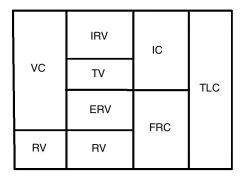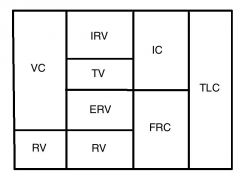![]()
![]()
![]()
Use LEFT and RIGHT arrow keys to navigate between flashcards;
Use UP and DOWN arrow keys to flip the card;
H to show hint;
A reads text to speech;
19 Cards in this Set
- Front
- Back
|
Respiratory Lung Volume @ rest |

@ REST IRV + ERV are maximal muscle effort |
|
|
Respiratory Lung Volume after exercise |

after exercise - TV increases - IRV, ERV both decrease - RV remains same (never changes) - IC increases, FRC decreases |
|
|
breathing (ventilation) |
mechanical process caused by actions of certain skeletal muscle that moves air in and out of respiratory tract O2 required, CO2 eliminated |
|
|
Tidal Volume (TV) |
volume of air in OR out of lungs in ONE BREATH @ rest for males =0.5 litres, for females = 0.4 litres |
|
|
Inspiratory Reserve Volume (IRV) |
after inspiring resting TV, hold it, then using maximal muscle effort (mme), inspire as much air as possible and hold how much you can inspire after a normal inspiration |
|
|
Expiratory Reserve Volume (ERV) |
inspire and expire resting TV, stop breathing, using maximal muscle effort (mme) continue expiring air as much as possible how much you can expire after a normal inspiration and expiration cycle |
|
|
Residual Volume (RV) |
amount of air left in lungs after maximal expiration ** CANNOT be voluntarily removed ** |
|
|
Inspiratory Capacity (IC) |
IC = TV + IRV |
|
|
Functional Residual Capacity (FRC) |
FRC = ERV + RV |
|
|
Vital Capacity (VC) |
VC = IRV + TV + ERV |
|
|
Total Lung Capacity (TLC) |
TLC = IRV + TV + ERV + RV |
|
|
Factors Influencing Lung Volumes |
gender age height strength of respiratory muscles |
|
|
Why does tidal volume increase as level of activity increases? |
more exercise = higher CO2 production + increased O2 demand = sk. muscle highly active |
|
|
Forced Vital Capacity (FVC) |
VC forcefully exhaled, as fast as possible measures both amount of air moved and the rate at which air is moved divided into forced expiratory volume |
|
|
Forced Expiratory Volume (FEV) |
amount of FVC exhaled in a given amount of time FEV1 = amount of FVC exhaled in first second of expiration FEV2 = amount of FVC exhaled in first 2 seconds of expiration |
|
|
FEV1% |
FEV 1% = FEV1 / FVC |
|
|
Minute Ventilation (MV) |
volume of air moving into or out of respiratory tract in one minute to calculate need to know TV and VR MV = TV x VR = (L/breath) x (breaths/min) MV = L/min |
|
|
Alveolar Ventilation (AV) |
volume of air moving into or out of alveoli in one minute important because this is where gas exchange occurs AV = (TV - DS) x VR = L/breath x breath/min AV = L/min |
|
|
Anatomic Dead Spaces |
nonalveolar parts of the respiratory tract include nasopharynx, trachea, oral cavity, pharynx, nasal cavity average value of ADS in adult = 0.15 litres/breath |

